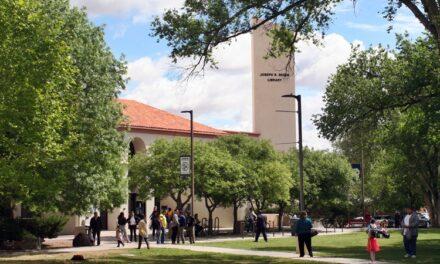
Ground was broken on the new fiber optic internet set to be installed to connect Midway and San Antonio elementary schools.
Cathy Cook | El Defensor Chieftain photos
Ground was broken Thursday on a project to bring high-speed internet to Midway Elementary.
The fiber project will connect Midway and San Antonio Elementary with high-speed fiber, making it easier for students and teachers to get their work done.
“I think having these last two schools connected is going to do a lot for our kids here,” said Socorro Superintendent Ron Hendrix. “They’ve kind of been at a disadvantage for years.”
The $1.2 million project is funded predominantly with federal dollars, although the state of New Mexico is also contributing $64,000 to the project.
Western New Mexico Communications will complete the project and estimates it will be done by the end of the year, although their goal is to get the network up and running by the time school starts in the fall. Although the ceremonial groundbreaking took place last week, not all of the required permits are in place yet, and construction cannot begin without them. They began working the permitting in 2021, said NM Director of Broadband Kelly Schlegel.
The permitting for fiber projects is extensive, especially because waterways, wildlife species and any tribal artifacts have to be protected, said Schlegel. There are 840 schools in the state and 360 of them needed a similar project, she said. There are four left on that list. The fiber project will address two of those four schools: Midway Elementary and San Antonio Elementary.

The Socorro Consolidated School District’s Director of
Technology Jeff Baxton MC’d the groundbreaking ceremony
Thursday.
“This becomes like a highway. This becomes a backbone major branch that we can launch off into the community. So now that we’re getting the schools connected, we want to launch off and get the community connected,” said Schlegel.
This is not the first attempt to bring fiber to Midway Elementary, said Schlegel. In the previous attempt, pole attachments were too expensive and tanked the project.
“Socorro has always been the innovator when it comes to technology and what they’re doing for the community and what they’re doing for students. When I look back to the early 2000s, Socorro was actually one of the first districts to start to implement fiber across the district, which is pretty amazing when you look back 20 years ago,” said Arsenio Romero, Secretary of New Mexico’s Public Education Department.
The first wireless connection at Midway was 20 megabits per second shared between both Midway and San Antonio, said the school district’s Director of Technology Jeff Tull. When testing ramped up bandwidth needs, that was boosted to 30 megabits. That is less than one percent of the 10-gig backbone that the district will bring from its main network to the two rural schools.
Tull was the master of ceremonies, calling up state and public officials, along with a Midway teacher and San Antonio principal to attest to the importance of the project. The project was a large team effort, said Tull.
The city, county, New Mexico Tech and the school district have been working together on a broadband committee for years to address the internet needs in Socorro County.
Gov. Michelle Lujan Grisham credited that collaboration as part of the reason internet access is as far along as it is in rural New Mexico and Socorro.
Reducing matching funds
State or federal funding for projects often requires local government to match a percentage of the funding with its own dollars.
Gov. Michelle Lujan Grisham complimented the state legislature and Representative Tara Jaramillo—who was present and is also a member of the Socorro School Board—on reducing the amount of matching funds required to obtain state funds for building new schools. Lujan Grisham suggested that the state legislature should eliminate the requirement for local matching funds altogether to build new schools.
“We have a lot of money in the state of New Mexico to build schools, and we don’t do it because the matches are so high, and we’ve nearly eradicated now building-new-school-matches, and I’m hoping, now I’m going to lobby Representative Jaramillo, I’d like to see us just take them away,” said Lujan Grisham.
The matching fund requirements for building schools were created when the state had less money, she said.
“It is not as if these communities are going to walk away from these schools. These educators are dedicated, as is the superintendent and the school board and President Hicks to making sure children succeed.”
Moving Education Forward
Lujan Grisham and Lt. Gov. Howie Morales both said that moving education forward in the state is not one step, but many.
Internet access is one way to make education more equitable.
“When you have some school districts in some areas of the state that don’t have the connectivity, then we’re not doing our job to make sure that we have equitable education,” said Morales.
Moving education forward in the state also requires compensating educators well and making sure that children’s needs are met before they reach grade school age, Lujan Grisham said.
The two gaps that keep her up at night are classrooms with too many kids in the class and not enough educators, and the coordination of services like behavioral services. Lujan Grisham believes if the state stays the course it’s set on, educational outcomes will improve.



















